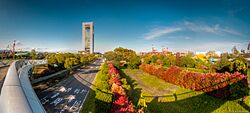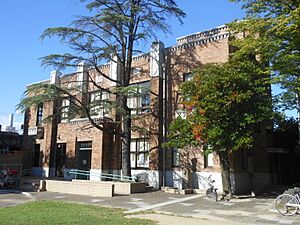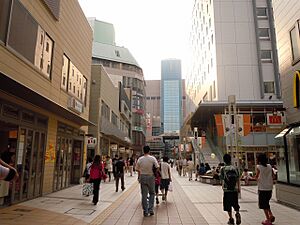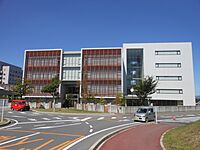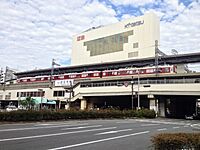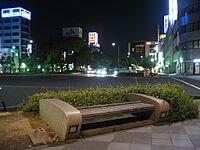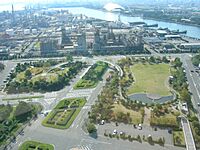Yokkaichi facts for kids
Quick facts for kids
Yokkaichi
四日市市
|
|||||||||||||
|---|---|---|---|---|---|---|---|---|---|---|---|---|---|
|
|||||||||||||
|
|||||||||||||
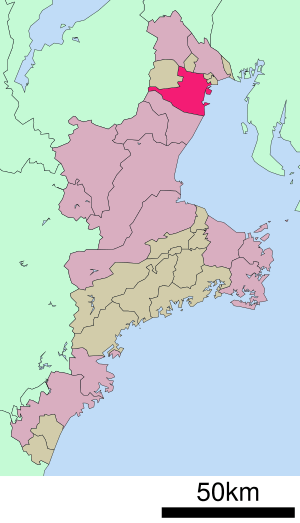
Location of Yokkaichi in Mie Prefecture
|
|||||||||||||
| Country | Japan | ||||||||||||
| Region | Kansai | ||||||||||||
| Prefecture | Mie | ||||||||||||
| Area | |||||||||||||
| • Total | 206.44 km2 (79.71 sq mi) | ||||||||||||
| Population
(August 2021)
|
|||||||||||||
| • Total | 310,259 | ||||||||||||
| • Density | 1,502.90/km2 (3,892.50/sq mi) | ||||||||||||
| Time zone | UTC+9 (Japan Standard Time) | ||||||||||||
| Phone number | 059-354-8244 | ||||||||||||
| Address | 1-5 Suwa-chō, Yokkaichi-shi, Mie-ken 510-8601 | ||||||||||||
| Climate | Cfa | ||||||||||||
|
|||||||||||||
Yokkaichi (四日市市, Yokkaichi-shi) is a city in Mie Prefecture, Japan. As of August 2021, about 310,259 people lived here in 142,162 homes. The city covers an area of 206.44 square kilometers.
Contents
Geography of Yokkaichi
Yokkaichi is located in the north-central part of Mie Prefecture. It is part of the northeastern Kii Peninsula. The city stretches across Mie Prefecture. To the east, it borders Ise Bay on the Pacific Ocean. To the northwest, it borders Shiga Prefecture.
Cities and Towns Nearby
Yokkaichi shares borders with several other places.
In Mie Prefecture
In Shiga Prefecture
- Kōka
Yokkaichi's Climate
Yokkaichi has a Humid subtropical climate. This means it has warm summers and cool winters. There is usually little to no snowfall. The average temperature each year is about 15.2 °C (59.4 °F). The city gets about 1,807.3 mm (71.15 in) of rain annually. September is the wettest month. Temperatures are highest in August, around 26.8 °C (80.2 °F). They are lowest in January, at about 4.3 °C (39.7 °F).
| Climate data for Yokkaichi (1991−2020 normals, extremes 1966−present) | |||||||||||||
|---|---|---|---|---|---|---|---|---|---|---|---|---|---|
| Month | Jan | Feb | Mar | Apr | May | Jun | Jul | Aug | Sep | Oct | Nov | Dec | Year |
| Record high °C (°F) | 19.9 (67.8) |
22.2 (72.0) |
24.5 (76.1) |
29.5 (85.1) |
33.1 (91.6) |
35.4 (95.7) |
37.9 (100.2) |
38.8 (101.8) |
36.9 (98.4) |
31.5 (88.7) |
24.8 (76.6) |
21.9 (71.4) |
38.8 (101.8) |
| Mean daily maximum °C (°F) | 9.0 (48.2) |
10.0 (50.0) |
13.3 (55.9) |
18.7 (65.7) |
23.2 (73.8) |
26.1 (79.0) |
29.9 (85.8) |
31.4 (88.5) |
27.7 (81.9) |
22.4 (72.3) |
17.0 (62.6) |
11.5 (52.7) |
20.0 (68.0) |
| Daily mean °C (°F) | 4.3 (39.7) |
4.9 (40.8) |
8.1 (46.6) |
13.3 (55.9) |
18.0 (64.4) |
21.7 (71.1) |
25.6 (78.1) |
26.8 (80.2) |
23.2 (73.8) |
17.5 (63.5) |
11.8 (53.2) |
6.6 (43.9) |
15.2 (59.3) |
| Mean daily minimum °C (°F) | −0.1 (31.8) |
0.0 (32.0) |
2.9 (37.2) |
7.9 (46.2) |
13.0 (55.4) |
17.8 (64.0) |
22.2 (72.0) |
23.2 (73.8) |
19.4 (66.9) |
13.0 (55.4) |
7.1 (44.8) |
2.0 (35.6) |
10.7 (51.3) |
| Record low °C (°F) | −6.0 (21.2) |
−6.3 (20.7) |
−4.6 (23.7) |
−1.1 (30.0) |
3.8 (38.8) |
9.8 (49.6) |
13.7 (56.7) |
15.8 (60.4) |
9.7 (49.5) |
2.2 (36.0) |
−1.0 (30.2) |
−5.6 (21.9) |
−6.3 (20.7) |
| Average precipitation mm (inches) | 55.5 (2.19) |
67.2 (2.65) |
117.8 (4.64) |
153.7 (6.05) |
189.3 (7.45) |
249.0 (9.80) |
208.0 (8.19) |
158.8 (6.25) |
286.9 (11.30) |
182.9 (7.20) |
79.7 (3.14) |
58.5 (2.30) |
1,807.3 (71.15) |
| Average rainy days (≥ 1.0 mm) | 5.9 | 7.2 | 9.2 | 9.2 | 9.9 | 12.3 | 11.7 | 8.9 | 11.5 | 9.4 | 6.1 | 6.4 | 107.7 |
| Average snowy days | 10.0 | 8.9 | 4.3 | 0.4 | 0 | 0 | 0 | 0 | 0 | 0 | 0.1 | 5.3 | 29 |
| Average relative humidity (%) | 68 | 67 | 65 | 67 | 73 | 79 | 83 | 79 | 80 | 75 | 74 | 71 | 73 |
| Mean monthly sunshine hours | 152.2 | 149.5 | 181.7 | 189.8 | 194.2 | 147.9 | 162.4 | 196.2 | 151.8 | 153.9 | 156.8 | 151.6 | 1,988 |
| Source: Japan Meteorological Agency | |||||||||||||
Population of Yokkaichi
The number of people living in Yokkaichi has grown steadily. This has happened over the last 60 years.
| Historical population | ||
|---|---|---|
| Year | Pop. | ±% |
| 1960 | 206,379 | — |
| 1970 | 241,409 | +17.0% |
| 1980 | 266,756 | +10.5% |
| 1990 | 285,015 | +6.8% |
| 2000 | 302,102 | +6.0% |
| 2010 | 307,807 | +1.9% |
History of Yokkaichi
The area where Yokkaichi is today has been lived in since ancient times. Many old burial mounds from the Kofun period have been found here. This area was also a battle site during the Asuka period Jinshin War. For a long time, it was just a small port village.
How Yokkaichi Got Its Name
The area grew a lot during the Kamakura period. By the Azuchi–Momoyama period, the port was busy. A regular market opened on the 4th, 14th, and 24th day of each month. This is how the city got its name: "yokka" means "fourth day," and "ichi" means "market."
From Edo Period to Modern City
After the Honnō-ji Incident, a famous warlord named Tokugawa Ieyasu escaped from Yokkaichi port by sea. During the Tokugawa shogunate, Yokkaichi was directly controlled by the shōgun. It was a busy stop on the Tōkaidō highway, which connected Edo (now Tokyo) with Kyoto. Sadly, a big earthquake destroyed much of the city during this time.
After the Meiji Restoration in 1889, Yokkaichi officially became a town. It was chosen as the capital of Mie Prefecture. The port of Yokkaichi grew a lot, thanks to a merchant named Inaba Sanuemon. He worked for 12 years to make the port modern. In 1899, it became an Official International Port. At first, the port traded things like seed oil, Banko ware (a type of pottery), and Ise tea. Today, it handles cotton, wool, glass, and heavy machinery. Yokkaichi became a city on August 1, 1897.
Yokkaichi in World War II
In 1939, Yokkaichi became a big center for the chemical industry. The Imperial Japanese Navy built a large oil refinery near the port. During World War II, Yokkaichi was one of the first Japanese cities bombed by the United States. This happened on April 18, 1942. Later, on June 18, 1945, many bombers attacked the city. They destroyed 35% of the city and killed 736 people. There were eight more air raids until August 8, 1945.
Recent History and Growth
From 1960 to 1972, people in Yokkaichi faced health problems. This was due to air pollution from local factories. A health condition called Yokkaichi zensoku (Yokkaichi asthma) is named after the city.
On November 1, 2000, Yokkaichi became a special city. This gave it more local control. On February 7, 2005, the town of Kusu joined with Yokkaichi.
Economy of Yokkaichi
Yokkaichi is a major manufacturing hub. It produces many different goods.
- Banko ware: A special kind of earthenware and stoneware.
- Automobiles: Cars and other vehicles.
- Textiles: Cotton fabrics.
- Chemicals: Various chemical products.
- Tea: Local tea products.
- Cement: Building materials.
- Computer parts: Such as flash memory made by companies like Kioxia and Western Digital.
Education in Yokkaichi
Yokkaichi has many schools for students of all ages.
Universities and Colleges
- Humanitec Junior College
- Yokkaichi Nursing and Medical Care University
- Yokkaichi University
Schools for Younger Students
The city government runs 38 public elementary schools and 22 public middle schools. There are also three private middle schools. For students with special needs, the city has one special education school.
High Schools
The Mie Prefectural Board of Education operates ten public high schools. There are also five private high schools. The prefecture also runs two special education schools for students with disabilities.
International Schools
- Escola Nikken (ニッケン学園) — A Brazilian school.
- Yokkaichi Korean Elementary and Middle School (四日市朝鮮初中級学校) — A North Korean school.
Transportation in Yokkaichi
Yokkaichi has a good transportation system. This includes railways, highways, and a seaport.
Railway Lines
* Tomida - Tomidahama - Yokkaichi - Minami-Yokkaichi - Kawarada
* Kintetsu Tomida - Kasumigaura - Akuragawa - Kawaramachi - Kintetsu Yokkaichi - Shinshō - Miyamado - Shiohama - Kita-Kusu - Kusu
* Kintetsu Yokkaichi - Nakagawara - Ise-Matsumoto - Ise-Kawashima - Takatsuno - Sakura
- Yokkaichi Asunarou Railway – Utsube Line
* Asunarou Yokkaichi - Akahori - Hinaga - Minami-Hinaga - Tomari - Oiwake - Ogoso - Utsube
- Yokkaichi Asunarou Railway – Hachiōji Line
* Hinaga - Nishihino
* Kintetsu-Tomida - Ōyachi - Heizu - Akatsukigakuenmae - Yamajo - Hobo - Hokusei Chūō Kōenguchi
Highways
 Isewangan Expressway
Isewangan Expressway Shin-Meishin Expressway
Shin-Meishin Expressway Higashi-Meihan Expressway
Higashi-Meihan Expressway National Route 1
National Route 1 National Route 23
National Route 23 National Route 25
National Route 25 National Route 164
National Route 164 National Route 306
National Route 306 National Route 365
National Route 365 National Route 477
National Route 477
Seaports
- Yokkaichi Port
Fun Things to Do in Yokkaichi
Yokkaichi hosts several exciting festivals and events throughout the year.
Festivals and Events
- Amagasuka Ishidori Festival
- Great Yokkaichi Festival
- Matsubara Ishidori Festival
International Connections
Yokkaichi has special relationships with cities and ports around the world. These are called sister cities and sister ports.
 Long Beach, California, United States (since October 7, 1963)
Long Beach, California, United States (since October 7, 1963) Sydney Port, Australia (since October 24, 1968)
Sydney Port, Australia (since October 24, 1968) Tianjin, China (since October 28, 1980)
Tianjin, China (since October 28, 1980)
Famous People from Yokkaichi
Many talented individuals come from Yokkaichi.
- Toshiya Fujita, a movie director
- Naoki Hattori, a racing driver
- Goseki Kojima, a manga artist
- Masayo Kurata, a voice actress
- Miki Mizuno, an actress
- Fumio Niwa, an author
- Katsuya Okada, a politician
- Takuya Okada, chairman emeritus of AEON Group
- Satoshi Saida, a wheelchair tennis player
- Naoki Segi, a movie director
- Shuu Shibutani, a professional wrestler
- Ui Shigure, a light novel artist and virtual YouTuber
- Yoriko Shono, a writer
- Ōzutsu Takeshi, a sumo wrestler
- Katsuaki Watanabe, former president of Toyota Motor Corporation
Images for kids
See also
 In Spanish: Yokkaichi para niños
In Spanish: Yokkaichi para niños


